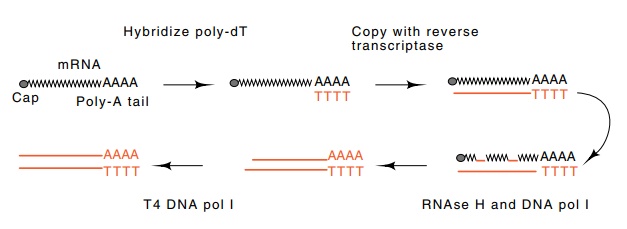Chapter: Genetics and Molecular Biology: Genetic Engineering and Recombinant DNA
Cloning from RNA
Cloning from RNA
Although
DNA can be extracted from cells and used in cloning steps, sometimes RNA is a
better starting choice for cloning. Not only will intervening sequences be
missing from mRNA, but often mRNA extracted from certain tissues is greatly
enriched for specific gene se-quences.
Extraction
of RNA from cells yields a preponderance of ribosomal RNA. The messenger RNA
can easily be separated from this ribosomal RNA since most messenger RNA from
most higher organisms contains a poly-A tail at the 3’ end. This tail can be
used for isolation by passing a crude fraction of cellular RNA through a
cellulose column to which poly-dT has been linked. At high salt concentrations,
the poly-dT which is linked to the column and the poly-A tails of messenger
molecules hybridize and bind the messenger RNAs to the column. The ribosomal
RNA molecules flow through the column. The messenger RNAs are eluted by
lowering the salt concentration so as to weaken the polyA-dT hybrids. Such a
purification step frequently provides a several-hundred-fold enrichment for
messenger RNA. The effort required to clone a specific gene is often greatly
reduced by using this procedure in con-junction with choosing a particular
tissue at a particular developmental time.
The
single-stranded RNA obtained by the steps described above cannot be cloned
directly. Either the RNA can be converted to DNA via a complementary strand,
cDNA, or the RNA can be used to aid identi-fication of a clone containing the
complementary DNA sequence. To generate a cDNA copy of the poly-A-containing
messenger, several steps are performed (Fig. 9.12). First, a poly-dT primer is
hybridized to the messenger and reverse transcriptase is used to elongate the
primer to yield a DNA copy. This enzyme, which is found within the free virus
particle of some animal viruses, synthesizes DNA using an RNA tem-plate. At
this point the sequence exists as an RNA-DNA hybrid. It is converted to a DNA
duplex by the simultaneous incubation with RNAse H which cuts the RNA strand in
an RNA-DNA duplex and DNA polym-

Figure 9.12
Steps in the replication of an
mRNA molecule into a double-stranded DNA copy suitable for cloning.
erase pol I which synthesizes DNA using the
remaining RNA as primer. DNA pol I removes the remaining RNA by nick
translation. Finally, to make the ends of the DNA duplex perfectly blunt, T4
DNA polymerase pol I is added. The resulting double-stranded DNA can then be
cloned by methods already discussed.
Related Topics